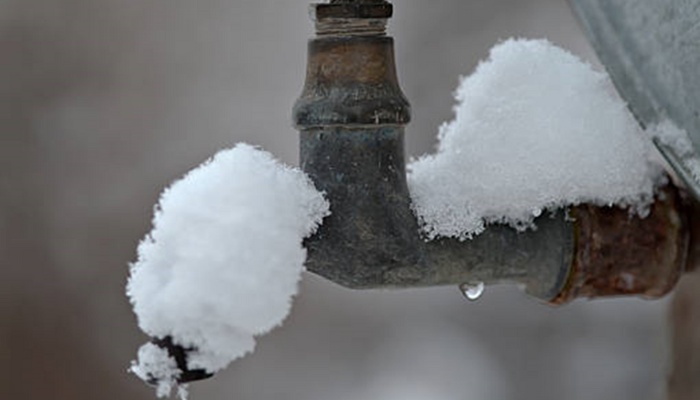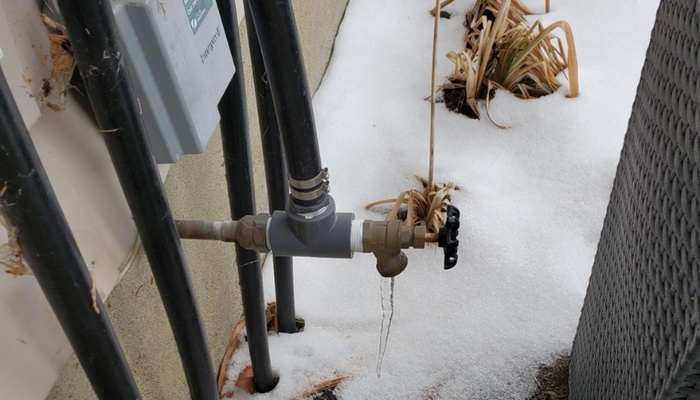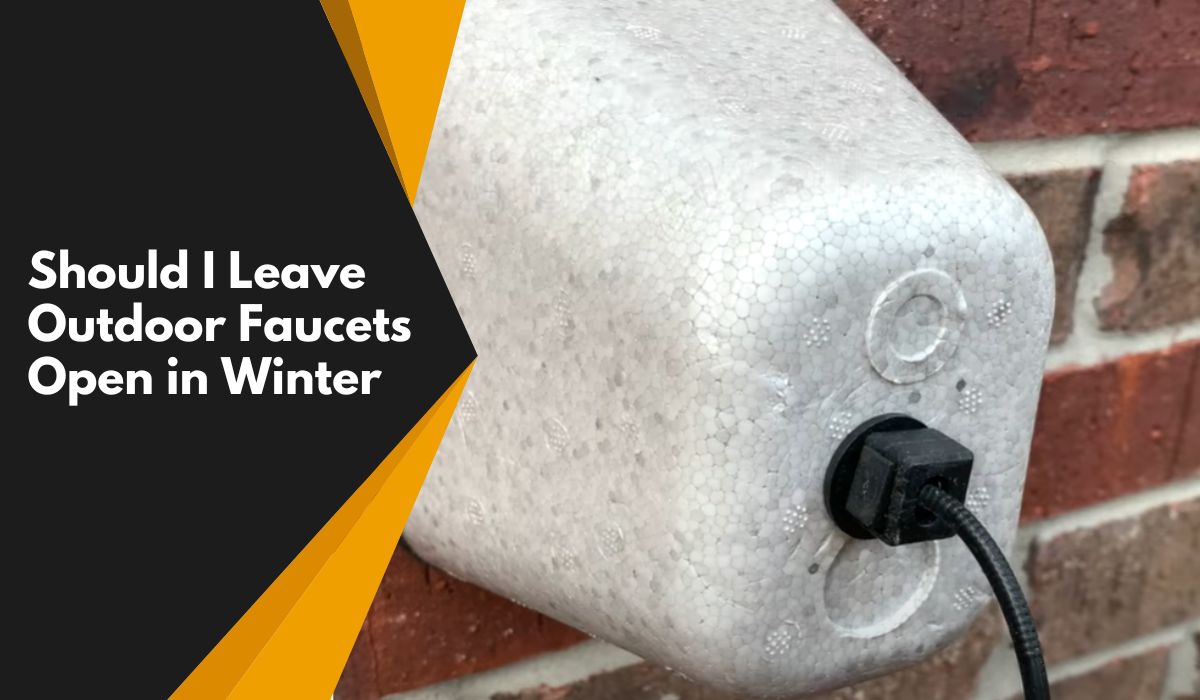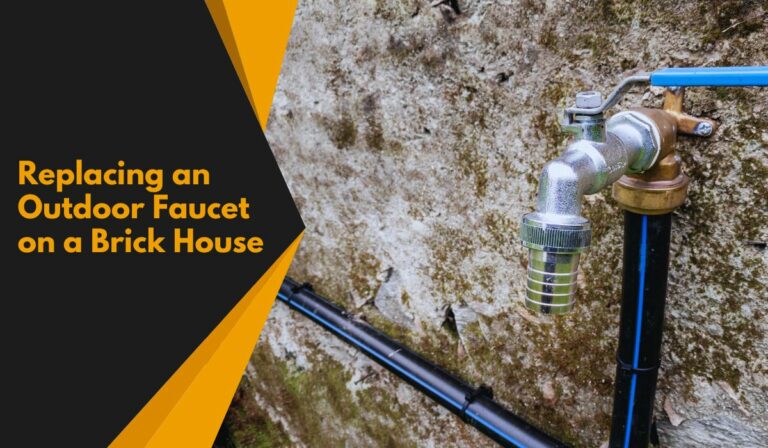Should I Leave Outdoor Faucets Open in Winter? Know the Right Way!
Worrying about the outdoor spigot in extremely cold weather is a common thing among homeowners. As it will cause the water inside the pipe to freeze up.
In winter, you should leave outdoor faucets open while turning off the shut-off valve that is inside your home. But, if your house is near the outdoor faucet, then it’s best to close both the outdoor faucet and shut-off valve.
No worries as I’ll break this down along with some useful details that help to keep the outdoor faucet safe in the winter. Let’s begin!
Leaving Faucets Open and Close Is All Okay Based on Condition!
If you’re wondering whether should I leave my outside faucet open or close, it’s okay either way depending on a few things. When it’s very cold outside, you can leave your outdoor faucet on or off.
But, you should definitely close the valve inside your house and let the water in the faucet drain. Doing this will prevent the pipe and faucet from freezing.
Water that’s moving doesn’t freeze as easily as water that’s sitting still. Another thing to know is that the water that’s moving comes from deep underground or from inside the house, and it has some heat in it.

This helps to keep the water from freezing in the pipes. But if the outdoor faucet isn’t wrapped up to stay warm, it can lose its ability to keep the water warm, unless the water is flowing pretty strongly.
So, when should you turn off the outside water in the winter? If it’s a super cold day, like -30°F – 55°F, then it’s a good idea to turn off the outdoor faucet and close the valve inside. Especially, I suggest closing the valve inside when it’s really close to the outside wall of your house.
For all busy folks, here’s a table to summarize when you should consider leaving outdoor faucets open or closed during winter:
Weather Conditions | Outdoor Faucet | Shut-Off Valve | Additional Notes |
| Mild Winter Weather (above freezing) | On or Off | Off | The moving water won’t freeze. But it’s better to turn off the valve to prevent early blockage and buildups. |
| Cold Weather (below freezing) | On | Off | Letting the faucet flow water can help to make the water icy. However, it’s required to close the valve to prevent pipe breakage. |
| Very Cold Weather (super low temperatures) | On | Off | Closing both the faucet and valve is recommended to get rid of freezing and pipe cracks. Especially for the faucet close to the house. |
| Extremely Cold Weather (sub-zero temperatures) | On | Off | As the risk of freezing is high, keep both the faucet and valve closed to avoid damage. |
This is because the super cold weather can make the pipe extremely cold and the water inside icy. Because of this, the valve might break and the water will keep flowing no matter what.
Why Should You Protect the Outdoor Faucet in Winter?
When it’s really cold outside, water trapped in an outdoor faucet can make the pipe get bigger by up to 9%. This can make the pipes burst and crack if you don’t protect the outdoor faucet.
If there’s too much water inside the outdoor faucet and it gets frozen, stuff like hard minerals can build up inside the pipe. This can block the path the water takes or even make the inside rusty.
Plus, the outdoor faucet or its parts can freeze and turn into ice in winter. Because of this, it can put a lot of pressure, around 100,000 PSI (Pound per Square Inch). That’s enough to break the faucet or pipe and make a big flood in your house.
What to Do with Outside Water Faucets in Winter?
Draining the faucet is the best way you can ensure no harm to it in the winter season. Let me show you the procedure:

Step 1: Close the Water Supply
Firstly, go inside and locate the water supply valve of the outdoor faucet to turn it off. In most cases, it is located close to the water meter in the basement or crawl space, or garage zone.
Once you find it, close the water valve. That way you can stop water coming from the faucet and causing the freezing issue. Don’t confuse the indoor water supply with the outdoor water faucet!
Step 2: Detach Hoses (If Attached)
Then, come back to the outdoor faucet area. Also, take out hoses or connectors to the faucet. Be sure to roll them up and then store them in a safe zone (like a garage or basement). And, if possible, drain all the water from the hoses to avoid damage.
Step 3: Drain the Water
After you have removed the connectors or hoses from the outdoor faucet, open the outdoor filter to drain the water. To do that, just twist the handle fully of the faucet and allow it to flow water for a while.
Keep on doing it until the water no longer comes out. And, if your inside shut-off valve contains a drain plug, ensure to unbolt it after placing a small bucket below.
Step 4: Turn Off the Outdoor Faucet and Insulate It
Once the water stops flowing, close the outdoor faucet by rotating the handle tightly. Then, cover the faucet with a towel or cloth so that it stays good in shape under cold weather. Or, you can use plastic bags or faucet insulators from a local plumbing store.
Ensure to lock an outside water faucet if you fear theft activity as it’s pretty easy to steal material used outside
Other Winterizing Techniques!
Apart from draining your outdoor faucet, some methods help winterize it for the good. Here are some of the ways:
- Store Hoses or Connectors: Ensure to remove hoses or connectors attached to the faucet so it doesn’t catch in extremely cold weather.
- Insulating Outdoor Faucets: Using a thin yet insulated cover or protector for your faucet on the outside will help keep the heat inside. That way it won’t freeze out the water in the pipe.
- Keep Your Home Warm: Turn on the heater, fireworks, and so on gears during the winter period. This trick works best for warming up the outside faucet near the house.
- Switch to Frost-free Faucet: Adding a frost-proof faucet on the outside will help the pipe and connectors to stay warm. And, in the winter, it won’t require draining the faucet too. In the case of a brick house, here’s how to replace the outdoor faucet on a brick wall.
How to Thaw a Frozen Outdoor Faucet?
If the cold weather makes your outdoor water faucet stuck and does not work, it’s really important to unfreeze it. To start, you’ll need some towels or pieces of cloth. Put them where the faucet is outside.

Then, go to your kitchen and heat up some water until it’s really hot. Pour this hot water onto the towels or cloth you put on the faucet outside.
Wait until the towels are wet from the hot water. You might need to do this a few times, maybe 3 to 5 times, for the best results.
Finally, go inside your house and turn off the valve that controls the water to the faucet. If there’s a plug, take it out. After that, you can open the outdoor faucet, and it should work again.
Ending Notes
Before the cold season arrives, it’s best to prepare all the things that help keep your outdoor faucet safe to face the challenges.
Be sure to follow the techniques given above to winterize it and try to leave the outdoor faucet open or close based on the situation.
Check your outdoor faucets weekly during winter. Regular checks can prevent 90% of winter-related plumbing issues
Hope you like this guide and find it beneficial to understand the main theme. Have A Wonderful Day!




![Outdoor Faucet Leaks When Turned On and Off [Solved]](https://faucetfam.com/wp-content/uploads/2023/07/Outdoor-Faucet-Leaks-When-Turned-On-and-Off-768x448.jpg)

![How to Repair a Leaking Anti Siphon Valve? [Solved]](https://faucetfam.com/wp-content/uploads/2023/07/anti-siphon-valve-leaking-768x448.jpg)